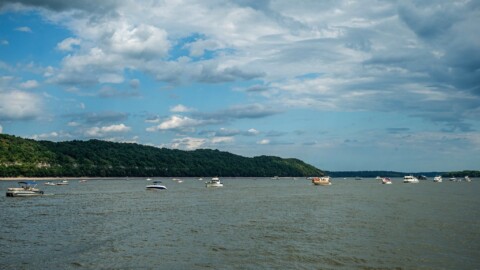
photo by Bailey Elizabeth Rogers
The quaint, historic town of Augusta has long been a principal location for Missouri’s lauded wine region, but this sleepy town is on the verge of big changes, as big development moves in with hopes of making it a national destination.

photo by Dave Adams

photo by Danel Petričević

photo by Mike Matney

photo by Dave Adams
The beginning of the 19th century was an auspicious time for white settlers in the St. Louis region, and a contentious, if not calamitous, period for the area’s native inhabitants. While the original French settlers had attempted to establish a report based around trade and mutual autonomy (so long as that did not threaten French interests) with the aboriginal people of Missouri and southern Illinois, the new American regime generally sought to usurp or extirpate their Native counterparts from a territory that was ever widening. The Louisiana Purchase of 1803 (from France) expanded the United States into a vast area west of the Mississippi River, and the 1804 Treaty of St. Louis unfairly duped Native Americans of their claim to lands east, west and north of the city, including where Augusta would eventually be founded.
The British, long a barrier between the nascent United States and its expressions of manifest destiny, provided Native Americans with supplies in their attempts to stymie American settlement of the Northwest Territory (ceded from the British during the American Revolution, though still somewhat occupied by British-controlled forts). Primarily motivated by anti-American strategy, those British in North America had largely upheld the French settlers’ coexistence agreements with Native American tribes, and encouraged them in fighting against American expansion. However, following their defeat in the War of 1812, British support for Native Americans vanished. The War of 1812 was in many ways the last domino to fall in a sequence accommodating the passage of America’s Indian Removal Act of 1830, resulting in the forced removal and relocation of no less than 60,000 Native Americans (estimates are as high as 100,000 with some 15,000 deaths resulting from the journey).
Following the War of 1812, Americans, including many who had served in the Virginia Militia during the War, were granted land stemming from their service and began to settle west of the Mississippi River. Among those, was Leonard Harold who platted and founded the village of Mount Pleasant (later, Augusta) in the 1830’s.

photo by Bailey Elizabeth Rogers

photo by RJ Wilner

photo by Maureen Minich

photo by Jason Gray

photo by Irene Griggs
In 1829, a former Warren County settler returned to Germany to publish his account of the benefits of relocating to Missouri. The man’s name was Gottfried Duden, and his publication, Report of a journey to the western states of North America and a multi-year sojourn in the years 1824 through 1827, did more to sell the idea of the New Rhineland than perhaps any other proselytizing for the idyls of Missouri life of the time. Duden reported in his book that Germans would be safer and more successful if they settled in groups, which became a practice resulting in the formation of several Missouri towns. Leonard Harold’s decision to establish a village upon a portion of his land with easy access to the Missouri River, was in part decided by a growing influx of German immigrants to the area (nearby Hermann is another example of German immigration upon this rural region).
Among those Germans to relocate to Augusta was George Muench. Muench purchased seven acres just outside of town in 1859, to build upon the community’s Old World interests in winemaking. His effort, later renamed after the original town moniker, would become its most prestigious vineyard–Mt. Pleasant Winery. By 1870, Augusta’s identity was firmly German, and boasted many indicators of German prosperity, including winemaking, a turnverein, various craftsmen and masons, several merchants of varying types, beer lagering, a church parish, hotels and inns, a dance hall (harmonie verein), and a library with many volumes in German. This influence was so strong in Augusta that, by the Civil War, the town which had been founded by a Virginian slave holder, had converted into a staunchly anti-slavery community. Another indication of this impact upon rural Missouri is the fact that wine production, stemming from this “New Rhineland”, was the largest by volume in the country by 1870, having overtaken the wine producing regions of New York and California (despite a temperance movement in Missouri at the time). Muench’s winery alone produced more gallons of wine than any other winery in the country. By the end of the 19th century, Augusta would have nearly two dozen active wineries.
In the mid-1870s, the Missouri River diverted away from Augusta’s riverfront. This slowed population growth, and perhaps cemented the community’s small town presence. Nonetheless, county roads north of town kept Augusta from being completely cut off from trade, and a rail line was eventually extended to the village in the 1890’s. Another blow, this time to both the community’s economy as well as its German heritage, came from the Nation’s prohibition of alcohol. All wine and beer production in Augusta was shut down, and the community transitioned over to other forms of agriculture. Fortunately, Mt. Pleasant Winery was reopened in the 1960’s–leading the charge once again for a new era.

photo by Jane DiCampo

photo by Maureen Minich

photo by Danel Petričević

photo by RJ Wilner

photo by Liz McCarthy
Despite a resurgence in wine production, Augusta remained principally a small town throughout the 20th century, with all of the benefits and challenges that distinction affords in this modern era. Over the last few years, however, David and Jerri Hoffman, owners of the Hoffman real estate empire, have quietly purchased hundreds of acres of commercial property in and around Augusta, including its largest extant vineyards and wineries. Their plan, under the guise of the Hoffman Family of Companies, is to convert this sleepy town in rural Missouri into the Midwest’s largest wine destination, a project that has been described as similar to Napa Valley in California. The project will include a variety of destination vineyards, five-star restaurants, luxury accommodations, trolley rides, paddleboat excursions and yacht tours, and most recently, the announcement of a new, 12-hole championship golf course. The Hoffman Family presence is already easily spotted around Augusta in innumerable buildings, sculptures, restored old vehicles, and more–all emblazoned with either a bronze plaque or painted logo for the company.
All of this investment is certain to change both the fortunes and pace of life for Augusta. What remains unclear is whether or not these changes are welcome. Based upon our interactions with Augusta residents, there is a split of opinion, though most do seem to favor the Hoffmans’ plan. Not since the early decades of its original German immigrants has so much potential been laid at the doorstep of this town along the indomitable Missouri River.

photo by Mike Matney

photo by Liz McCarthy

photo by Jason Gray

photo by Jane DiCampo

photo by Jen Smith







